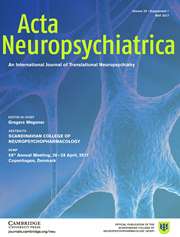Article contents
Baseline working memory activation deficits in dimensional anxious depression as detected by magnetoencephalography
Published online by Cambridge University Press: 20 January 2015
Abstract
Anxiety often co-occurs with major depressive disorder (MDD). This preliminary study sought to ascertain the extent to which anxious depression drives group neurobiological differences between patients with MDD and healthy volunteers (HVs).
Magnetoencephalography beta-band frequency was used to compare differences in brain response during the N-back working memory task between 30 medication-free patients with treatment-resistant MDD (anxious depression=18; nonanxious depression=12) and 28 HVs.
Compared to HVs, patients with anxious depression had significantly reduced desynchronisation (less activation) in the left precuneus, right cuneus, and left insula extending into the inferior and middle frontal cortex during the 2-back condition compared with the 1-back condition of the N-back working memory task – indicating less activation of these neural networks in patients with anxious depression during the condition with the highest level of task demands. No other significant group differences were found during the working memory conditions.
This preliminary study suggests that a subset of patients – those with anxious depression – may be driving observed group differences between patients with MDD and HVs. Further neurobiological studies and replication experiments are necessary to determine the extent to which this subgroup has preferentially influenced our understanding of the underlying neurobiology of depression.
Keywords
Information
- Type
- Original Articles
- Information
- Copyright
- © Scandinavian College of Neuropsychopharmacology 2015. This is a work of the U.S. Government and is not subject to copyright protection in the United States.
References
- 9
- Cited by


